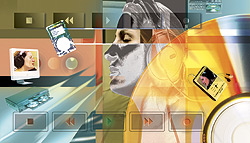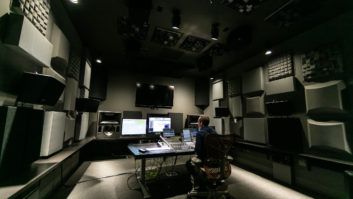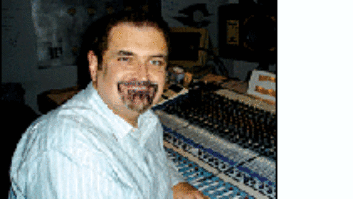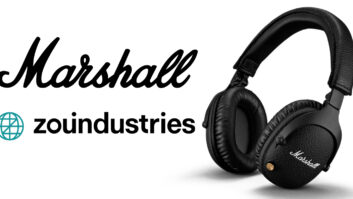

Here’s a simple logic problem: If all audio engineers are consumers, does that mean all consumers are audio engineers? That’s right, the answer to that one is a big “no,” and it’s an important fact to face up to in the argument over audio quality.
It may seem hard to believe, but the vast majority of the human race’s interaction with music has nothing to do with producing it. They listen to music and acquire the media it is distributed on — sometimes paying for it, sometimes not. But in a time when audio engineers have broken new ground in audio quality with formats such as SACD and DVD-A featuring 24-bit/96k in 5.1, why is the consumer vote resoundingly on the side — at least for now — of the less-inspiring sounds of Advanced Audio Coding (AAC) and MP3-encoded audio?
David Pakman is COO of eMusic (www.emusic.com), which was one of the first in the barrage of companies to sell songs and albums in the MP3 format and launch a digital music subscription service. As he sees it, the golden ears of the record industry and the customers are going in different directions. “There is a disconnect,” says Pakman, “between where the music industry is heading in terms of audio quality and fidelity, and the direction consumers are going, which is portability and convenience.
“For the first time in the digital revolution, consumers took a substantial step backward in quality with the adoption of the digital format,” he continues. “Thirty-three rpm records over 78s were an improvement in quality; SACD over 16-bit/44.1 was an improvement. But for convenience’s sake, they have taken a step back in perceptual quality.”
According to John Barrett, director of research for Parks Associates (www.parksassociates.com), a Dallas-based market research and consulting firm focused on digital products and services, the compressed tastes of today’s consumers can be traced to the limitations of the earliest digital audio players (DAP). The first units, such as the groundbreaking Eiger Labs F10, which was the first to appear on the American market in 1998, had just 32 MB of memory — enough to hold 10 or so songs if they were compressed down to 128 kbps. “When these things first came out, the portable digital players had limited space and you had to tolerate lower quality,” Barrett points out. “People thought, ‘Well, it’s not so bad,’ and they stuck with it.
“Today, you just have momentum behind the MP3 format. That was what most of the devices and software packages supported when they came out. Also, your average consumer can’t really hear the difference.”
Neural Audio (www.neuralaudio.com), a firm that develops digital signal processing platforms in stereo and 5.1 for compressed audio providers such as XM Satellite Radio, has built a business around algorithms that deliver as much music to consumers as possible without them noticing that a whole bunch of bits are missing. “The way people consume music is changing,” notes Geir Skadden, CEO of Neural Audio. “They’re consuming a lot more, which is good, but they may be consuming less in what you would call ‘critical listening.’ There are fewer people coming home from work and playing their favorite songs just to chill out; on the other hand, everywhere they go, all day they have music in the background.
“You have this boom in casual listeners,” he continues. “They are willing to trade convenience for quality in a big way; you cannot ignore that. We’re trying in that trade-off to preserve as much quality as we can. Quality in music is such a subjective thing. What we’re trying to preserve is the artist’s and producer’s intent — whether or not that’s quality is not for us to decide. So going for transparency is the scientific side of it.”
The pie charts above demonstrate a gradual shift in unit distribution; as Web and “other store” (i.e., Walmart) sales grow, record stores take a hit. Note: Number do not equal 100 percent.
Data courtesy RIAA
Right now, the hype is unquestionably on the side of the stylish iPod. The signature DAP from Apple (www.apple.com) has sold 10 million-plus units from its introduction in 2001 through January 2005, with a whopping 75 percent of those sales coming in 2004 alone and 40 percent during the past three months of 2004; another 150 million songs have been sold via the iTunes Music Store. But David Kawakami, North American director of Sony Corporation of America’s SACD (Super Audio CD) Project and a key developer of the high-fidelity Sony/Philips Direct Stream Digital recording process, cautions against being blinded by the buzz. “Right now, music downloads have an inordinate mind share,” he says. “However, the total revenue the music industry garners from sales to online stores is only a tiny percentage of its total business. Including sales to ring tones — which is much more lucrative than sales to iTunes or the other online stores — the total revenue for the major labels still hovers around five percent. Granted, they are enjoying a meteoric rise, but that’s not hard [to believe] if you consider that a little over two years ago, sales were essentially zero. The more important question is how high online businesses will go as a percentage of total revenue: 10? 20? 50 percent? If you ask 10 people in the music business, you will get 10 [different] answers.
“As to the relative sonic quality of music delivered on SACD or DVD-A versus online, the short answer is that for the download model, sonic quality is not an issue,” Kawakami continues. “Listening to music on nice speakers in your living room versus listening to music with earbuds while you’re on the go are totally different applications, and they are also totally different businesses. The problem as I see it is that in this all-or-nothing world in which we live, it’s very hard for the music industry to identify the different segments of the market and target them with products and services that appeal to those different consumers. Instead, you see an industry that is always looking for the panacea — the one product that will fit all — rather than aggregating a number of businesses of varying sizes into a total business plan.”
For DTS (www.dtsonline.com), one of the leading developers of decoders for 5.1 and 6.1 processors and the source of DVD-A releases for artists such as Crystal Method, Frank Zappa and Porcupine Tree, the challenge lies in turning consumers on to higher-quality formats. The reasoning is that once experienced, consumers will not be inclined to look back. “For people who have been exposed to surround sound music, the response is overwhelmingly positive,” says Brian Towne, VP, consumer division of DTS. “However, we realize it’s still a nascent market and there’s still a lot of uncertainty.
“There is a market for higher-resolution formats,” Towne continues. “Unfortunately, it’s still in its infancy. I think consumers — regardless of what they purchase — are looking for a quality audio experience. Education of what truly is possible is an ongoing process, and because we see such a broad range of equipment, from very entry-level prices up into the stratosphere, I do think consumers care. I’m not certain we’ve reached out yet and educated the vast majority of them about what is possible.”
One such educator in the field is Elliot Fishkin, owner and president of Innovative Audio Video (www.innovativeaudiovideo.com), a high-end Manhattan retail showroom where the transporting possibilities of high-quality music delivery are presented at their most extreme. “A music system that’s terrific is a time-travel machine,” he states. “It can take you from the present and make you believe that you actually were there when those people did it — as if you went to where people like Louis Armstrong and Duke Ellington were when they recorded it. You feel their joyousness, that it’s a performance for you that was captured with these recordings. In my imagination, they were singing to me.”
If such an amazing sensation is what can be delivered by listening to a high-resolution format or a finely tuned home theater, or both, why aren’t more consumers going for it? Once cost is taken into account, the advantage swings back toward online deliverable compressed formats. “My instincts tell me that consumers won’t pay more for higher audio quality,” says Parks Associates’ Barrett. “People will pay more for higher-quality video — they may pay more for a DVD over a VHS tape — but it’s the way music is used [that changes the equation]. People aren’t paying that much attention: They don’t normally listen to an album on a couch front to back and absorb it all in like a movie.
“The people that are adopting digital music tend to be distinct from the audiophile group,” he continues. “What may happen is if you had better-quality encoding methods, you could capture the higher-end audio crowd, but for the mainstream crowd, they’re not clamoring. Given two choices at the same price, they’d opt for the better, as long as it’s still the same file size.”
“I’m not arguing against higher-fidelity formats, but the public is,” says eMusic’s Pakman, who himself is also a recording studio owner that frequently records in 96 kHz/24-bit. “Certainly, the mass market has not shown any sign at all of rejecting MP3. There are many reasons why the public has thus far voted for compressed audio with their pocketbooks, especially given that the availability of content in the MP3 format is much larger than SACD or DVD-A. There is less perceptibility [between MP3/AAC-encoded and higher-resolution formats], and the mass market either can’t hear the difference or doesn’t appreciate it enough to pay for new hardware and re-purchase their CD collections in higher-fidelity format.
Rumors of the industry’s demise are greatly exaggerated: CD shipments rose slightly in 2004, a sign of optimism after a steady four-year decline. DVD-Audio and SACD shipments slipped, however, due in part to limited title releases.
Data courtesy RIAA
“Higher-resolution formats also don’t achieve the portability and convenience factor that digital media allows us. Digital media is portable: It can be moved from device to device, and some media in digital format can be copied, which allows for some additional portability and archival backup. It also allows you to make your own playlists, change ordering, do all sorts of funky stuff. But with DVD-A or SACD, you’re still limited to the functionality of a CD. I’m just stating the fact that a large part of the market is purchasing music in a lower-fidelity form because it’s convenient and portable, and that’s coinciding with a general rejection of much-higher fidelity formats by the mass market.”
But far from painting a picture of a close-minded consumer base, Skadden believes that the current lower-fidelity state of affairs opens up the door for a successful music and recording industry more than ever before. “The use of compression as mainstream distribution is dumbing down the consumer as to what fidelity is; no question about it,” he concedes. “That said, it widens the variety of content that is easily accessible to the consumer and that should not be underestimated.
“That’s important to the music industry because it gives you a broader marketing platform. Let’s say you’re making a format that is not mainstream or picked up on the Top 20 in the country. If you make it for iTunes, people will hear it and listen to it, they’ll go and buy the SACD and/or surround format and say, ‘Wow, now I really like it.’ So there’s an up-sell side here if you embrace the opportunity. You can say CD sales are down because people are dumbed down and buying off of iTunes, and that’s the typical sad story. But as digital music is maturing as a viable economic model, you still have the up-sell because the quality of digital is not as good as what you get in stores. So you end up getting the best of both.”
Kawakami agrees that the question isn’t whether or not consumers are taking advantage of high-resolution formats, but whether, with a projected 10 million SACD players being sold by the end of 2005, the music industry itself is. “Currently, about three SACD titles are released per day,” he says. “That’s about 90 per month or 1,000 per year. The total number of titles available worldwide is approaching 3,000. [See
www.sa-cd.net
for more information. — Eds.] However, most of the SACD releases are coming from the so-called ‘indies,’ not the majors, who are not looking for market segments but the ‘panacea product.’
“Independent labels tend to fly lower to the ground and seem to be better at exploiting specific market segments, and they are not insignificant. The majors, with their deep catalogs, actually have an enormous amount to gain with SACD. Take, for example, Pink Floyd’s Dark Side of the Moon. Thanks to [remastering engineer] James Guthrie’s wonderful 5.1 mix of this classic title, Capitol/EMI has shipped over 1 million copies of Dark Side on SACD. Not bad for a 30-year-old record! But it is not only incremental sales that the record industry is missing out on, it is also missing out on the opportunity to migrate the consumer to a secure format. The high-resolution SACD layer cannot be ripped and file-shared, so what were those million Floyd fans buying if not quality? After all, they can download Dark Side for free anytime they want.”
For Fishkin, the key to solving the consumer puzzle is the word quality itself — not just how the sample/bit rates and speaker connections measure up, but where audio fits in the multitude of quality-of-life decisions that people make every day. “I think it’s important that people listen to music, and I’m happy that they do it in any way that they do,” he says. “I just hope that those who want to seek something better know it’s out there.
“You can think of many choices that people make to make them feel better: what they eat, what they wear, a happy family life — all these things are variable. Seeking happiness and to go for life with gusto is what it’s about. If you have a stereo system that costs $1,500, that’s better than an iPod, and I suggest that if you spend that, you should sit down once in a while and listen to it. It’s a question of how you use it, not just how you have it.”
David Weiss is Mix’s New York editor.

Click here to download a PDF of the RIAA’s 2004 Year End Marketing Report on U.S. Record Sales of prerecorded music (data provided courtesy of RIAA).
Curious to know just how much iTunes and iPod sales have grown over the last few years? Click here to find out this and much, much more in this very thorough history of Apple’s beloved gadget.
What’s the Number One selling SACD? It’s not what you think. Click here to check out the SACD Top Ten.





